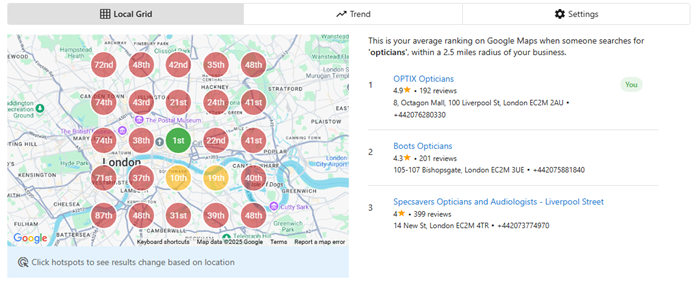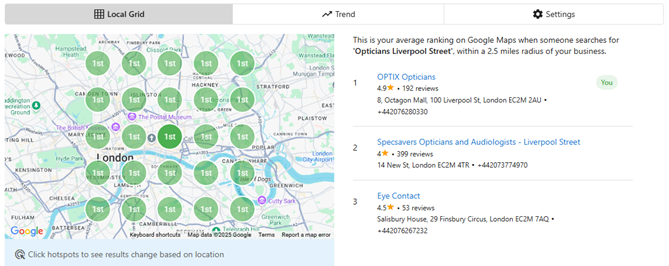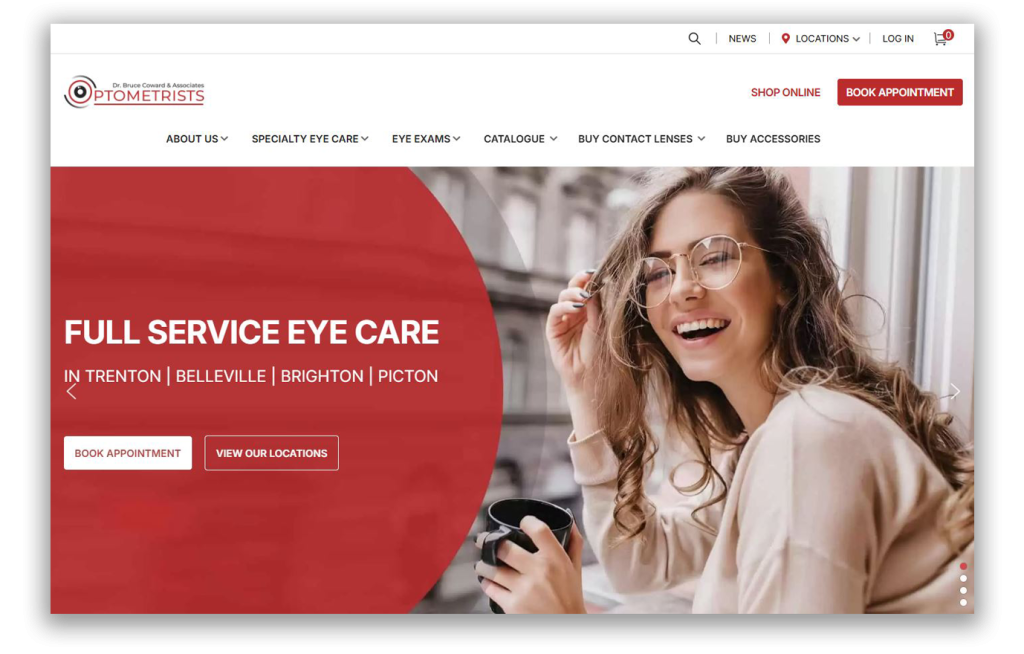Standing out online in a competitive market like the eyecare industry is essential for optical practices looking to attract new patients. Effective SEO for opticians and their websites can help practices like yours appear at the top of search results on search engines such as Google, especially for local searches, which can directly drive online bookings and increase in-store footfall.
In this blog, we explore practical SEO tips for optical practices based on success-proven strategies we’ve implemented for many of our own clients. Our aim is to help you understand and apply local SEO for opticians so you can rank higher on Google and fill your appointment book more easily.
Why SEO Is Vital for Opticians
1. Reach Patients Who Are Actively Searching
According to Statista, a leading provider of market intelligence, 75% of consumers in the United Kingdom and United States said they used Google when looking for local businesses online. This means if you are not ranking near the top for terms like optician near me, potential customers seeking your services will likely not find you, leaving your practice behind competitors who do show up.
2. Outperform Competitors in the Local Market
BackLinko, a platform that specialises in advanced SEO, reported that:
- The #1 result in Google’s organic search results has an average Click-Through Rate (CTR) of 27.6%.
- The #1 organic result is 10x more likely to receive a click compared to a page in the #10 spot.
- On average, moving up 1 spot in the search results can increase CTR by nearly 3% depending on where you’re moving from and to. For example, moving from #3 to #2 will usually result in a significant CTR boost, whereas moving from #10 to #9 doesn’t make a statistically significant difference.
Focusing on local SEO for opticians ensures your practice is visible where it counts – on the front page of Google.
3. Enhance Credibility and Trust
Businesses with well-ranked websites are often perceived as more credible and trustworthy overall. For eyecare professionals, this added credibility can encourage first-time patients to choose your practice over competitors, and OptiCommerce has helped countless optical websites rank where they need to – in front of your customers.
Understanding Local SEO for Opticians
Local SEO refers to the process of improving the online visibility of your practice and website, resulting in you appearing in more search results when people nearby are looking for services like yours. For example, “optician near me” or “eye test in [your town]” are some of the searches you could expect your customers to look for on Google. This is essential for opticians because the majority of people will only travel a short distance to access eyecare services.
When someone searches with local intent, Google uses three key factors to determine which businesses to show:
- Relevance – how closely your eyecare services match the search
- Distance – how close your practice is to the person searching
- Prominence – how trustworthy and well-established your online presence is
To rank well locally, you need to optimise both your website and your Google Business Profile (GBP). This includes making sure your contact details (name, address, phone number – or NAP) are consistent across the web, using locally relevant keywords (like “opticians in Sheffield”), and actively collecting customer reviews.
As well as GBP, other listing centres require updates around NAP. Whilst GBP is the primary offsite directory, mass updating other directories is also good practice. Opticommerce provides a tool that does just that and also allows you to measure important keywords vs. your direct competitors. This helps you benchmark your local SEO rank and monitor its progress.
It’s also helpful to publish location-specific content on your website, such as blog posts or service pages that reference your town, neighbourhood or nearby landmarks. Ultimately, local SEO for opticians helps your practice appear when people are actively searching for services you offer, increasing the likelihood that they’ll book an appointment with you instead of a competitor.
Essential SEO Tips for Optical Practices
1. Do Keyword Research with Your Patients in Mind
Start with keywords such as opticians in [Your Town] and eye test near me. OptiCommerce uses premium SEO tools like SEMrush and AHRefs to help measure and optimise clients’ SEO. We also use free tools like Google Search Console, which helps monitor, maintain, and troubleshoot your site’s presence in Google Search results.
If you currently use Google paid advertising (Google Ads), Keyword Planner is a very useful tool for finding new keywords and the potential volume of related searches in your area. It can also help identify the exact terms your future patients are searching for. We then incorporate these keywords naturally into your website copy, page titles, headings, and meta descriptions.
One of our clients, Optix Of Broadgate, moved location around 12 months ago. To maintain their rank, our team of online experts used specific SEO tools to ensure their practice would stay visible online to local customers. As a result, in an area with several large multiples, Optix ranks highly in local search results. See below:


2. Optimise Your Google Business Profile
- Ensure your name, address, telephone and opening hours are accurate.
- Upload professional, up-to-date photos of your practice.
- Use the Posts feature to share seasonal updates or promotions.
- Encourage satisfied patients to leave reviews, and always respond professionally.
An optimised Google Business Profile increases your chances of appearing in the Google Map Pack – the top three local results displayed above the standard organic listings.
3. Use Local Content to Show Expertise
Create content that speaks directly to your geographic area. You could write:
- A blog post like “How to Choose an Optician in [Your Town]”
- Guides on local school vision testing
- Updates on nearby community health initiatives
These demonstrate authority to search engines and help you rank for highly relevant search queries from your customers.
4. Build Local Citations and Business Listings
A study conducted by BrightLocal, a platform specific to local SEO and online visibility, found that:
- 93% of consumers say they are frustrated by incorrect information in online directories
- 80% of consumers lose trust in local businesses if they see incorrect or inconsistent contact details or business names online
- 40% would give up looking for a local business that they couldn’t find because the address was wrong online
- 68% of consumers would stop using a local business if they found incorrect information in online directories
Make sure your business name, address and phone number (NAP) are consistent across listings on Yell, Yelp, NHS.uk, Healthgrades and others.
5. Create High Quality, Engaging Pages
Build individual pages for each of your services and locations. Include:
- Clear, informative copy
- Customer testimonials
- Before-and-after photos (with consent)
- Prominent calls to action like “Book Your Appointment” or “Find Us Today”
Each page should be designed to meet the specific needs and questions of your local audience.
6. Optimise for Mobile
Think about how often you search for something on your mobile phone. Your customers will be doing the same, so your website must:
- Load quickly on smartphones and tablets
- Use large fonts and clear buttons for calls and bookings
- Feature mobile-friendly forms with minimal input required
7. Acquire Relevant Backlinks
Backlinks from trusted local websites signal credibility to Google. Reach out to local newspapers, event organisers or bloggers to feature your practice.
You could also host or sponsor community eyecare events, or contribute expert content to regional publications. This will create brand awareness for your business, instil trust in your customers and create an overall positive connotation with your practice.
8. Track and Improve Performance
Use Google Analytics and Google Search Console to track:
- Which pages are bringing in traffic
- What keywords lead to bookings
- Where users drop off in the process
These insights can help you refine your site and ensure that SEO efforts translate to patient appointments.
Crafting a Website That Patients Love
SEO is about visibility, but user experience (UX) and user interface (UI) drive conversions. Here’s what makes a difference:
- Simple site navigation: Make it easy for visitors to find services, contact information, and your appointment booking form.
- Fast page speed: Compress images and avoid heavy design elements that slow down load times.
- Clear calls to action: Every important page should invite users to do something – “Book Now”, “Download a Guide” or “Call Us Today”.
- Trust indicators: Display professional accreditations, client testimonials, and certifications to reassure new visitors.
Dr. Bruce Coward and Associates is a family-owned group of practices that has earned trust in its community. As a result, it’s incredibly important that its website reflects this trust. When we created their website, it was essential that it covered the details of the extensive services they provide in a simple, easy-to-navigate, and engaging format. Easy call-to-actions, client testimonials, and clear messaging help inform new and existing patients.

Suggested Call to Actions
Calls to action (CTAs) should be prominent and persuasive:
- Homepage banner: “Need an Eye Test? Book Today – Same Week Appointments Available”
- Service pages: “Learn more about our advanced contact lens fittings”
- Blogs: “Like this article? Download our Free Guide: ‘Understanding Children’s Vision’”
- After booking: “Refer a friend and get 10% off your next pair of glasses”
- Contact options: telephone number, web form and web diary
Key Metrics to Monitor
Once your SEO strategy is in place, you should track the following metrics:
- Keyword rankings: Especially for searches like “optician near me” or “[town] eye test”.
- Organic traffic: See how many people are visiting your site from unpaid search results.
- Appointments booked online: Your ultimate conversion metric.
- Review quantity and rating: These impact both visibility and trust.
- Click-through rates: Optimise page titles and descriptions to improve how often users click your link.
- Domain authority: a search engine ranking score developed by Moz to predict a website’s ability to rank well in search engine results pages
We understand it can feel like a second job trying to manage all of this information, let alone optimise it, and that’s why OptiCommerce came to exist in the first place. We’re a team of digital experts, but many of us started out as eyecare professionals ourselves, so we understand the value of this work along with the skills required to execute it.
In Summary
Step > Action
1. Research local keywords and search trends
2. Fully optimise your Google Business Profile
3. Create local content and targeted service pages
4. Maintain accurate listings across the web
5. Design for mobile and fast performance
6. Use strong, visible calls to action
7. Track key metrics and adjust accordingly
Ready to Grow?
Local SEO for opticians is one of the most effective ways to grow your optical practice sustainably. By following these SEO tips for optical practices, you’ll attract more patients, rank higher on Google, and stay ahead of competitors in your area.
If you’d like expert guidance on optimising your website and search visibility, contact OptiCommerce today. Our digital marketing team specialises in helping optical practices thrive online – and we’d love to help you do the same.




